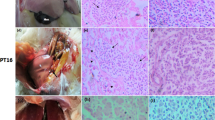Summary
The objective of this study was to characterize the genome structure of duck hepatitis B virus (DHBV) isolated from Hubei brown ducks. The natural carrier rate of DHBV in adult ducks from Hubei area was investigated and the DHBV DNA-positive serum screened out. The complete genome of a DHBV strain was amplified by polymerase chain reaction (PCR) and cloned into T vector and sequenced. The results showed that the carrier rate of DHBV in Hubei brown ducks was 10 %. This strain (GenBank accession number DQ276978) had a genome of 3024 nucleotides with three overlapping open reading frames encoding the surface, core and polymerase proteins respectively. Comparison of the strain with 17 DHBV strains registered in GenBank revealed a homology from 89.3 % to 93.5 % at the nucleotide level. The sequences of the structural and functional domains of these proteins were highly conserved. The strain was found to share more signature amino acids in the polymerase genes with the “Chinese” DHBV strains than those of the “Western” country strains. This finding was also corroborated by a phylogenetic tree analysis. Therefore, the DQ276978 might belong to a subtype of the Chinese DHBV strains.
Similar content being viewed by others
References
Duflot A, Mehrotra R, Yu S Z et al. Spectrum of liver disease and duck hepatitis B virus infection in a large series of Chinese ducks with hepatocellular carcinoma. Hepatology, 1995,21(6):1483–1491
Gunther S, Li B C, Miska S et al. A novel method for efficient amplification of whole hepatitis B virus genomes permits rapid functional analysis and reveals deletion mutants in immunosuppressed patients. J Virol, 1995,69:5437–5444
Triyatni M, Ey P, Tran T et al. Sequence comparison of an Australian duck hepatitis B virus strain with other avian hepadnaviruses. J Gen Virol, 2001,82 (pt2):373–378
Mangisa N P, Smuts H E, Kramvis A et al. Molecular characterization of duck hepatitis B virus isolates from South African ducks. Virus Genes, 2004,28(2): 179–186
Cova L, Lambert V, Chevallier A et al. Evidence for the presence of duck hepatitis B virus in wild migrating ducks. J Gen Virol, 1986,67:537
Li J S, Tong S P, Wands J R. Characterization of a 120-Kilodalton pre-S-binding protein as a candidate duck hepatitis B virus receptor. J Virol, 1996,70:6029–6035
Guo H T, Mason W S, Aldrich C E et al. Identification and characterization of avihepadnaviruses isolated from exotic anseriformes maintained in captivity. J Virol, 2005,79(5):2729–2742
Mandart E, Kay A, Galibert F. Nucleotide sequence of a cloned duck hepatitis B virus genome comparison with woodchuck and human hepatitis B virus sequences. J Virol, 1984,49(3):782–792
Molnar-Kimber K L, Summers J W, Mason W S. Mapping of the cohesive overlap of duck hepatitis B virus DNA and of the site of initiation of reverse transcription. J Virol, 1984,51(1):181–191
Mattes F, Tong S, Teubner K et al. Complete nucleotide sequence of a German duck hepatitis B virus. Nucleic Acids Res, 1990,18(20):6140
Uchida M, Esumi M, Shikata T. Molecular cloning and sequence analysis of duck hepatitis B virus genomes of a new variant isolated from Shanghai ducks. Virology, 1989,173(2):600–606
Morozov V, Pisareva M, Groudinin M. Homologous recombination between different genotypes of hepatitis B virus. Gene, 2000,260(1–2):55–65
Beck J, Nassal M. A sensitive procedure for mapping the boundaries of RNA elements binding in vitro translated proteins defines a minimal hepatitis B virus encapsidation signal. Nucleic Acids Res, 1996,24:4364–4366
Tang H, McLachlan A. A pregenomic RNA sequence adjacent to DR1 and complementary to epsilon influences hepatitis B virus replication efficiency. Virology, 2002,303:199–210
Zuker M. Mfold web server for nucleic acid folding and hybridization prediction. Nucleic Acids Res, 2003,31(13):3406–3415
Tavis J E, Ganem D. RNA sequences controlling the initiation and transfer of duck hepatitis B virus minus-strand DNA. J Virol, 1995,69:4283–4291
Author information
Authors and Affiliations
Additional information
This project was supported by a grant from the National Key Science and Technology Program of the Tenth Five-years-Plan (No. 2001BA705B05) and a grant from National Natural Sciences Foundation of China (No. 30271170).
Rights and permissions
About this article
Cite this article
Hu, Q., Zhang, X., Lei, Y. et al. Molecular characterization of duck hepatitis B virus isolated from Hubei brown ducks. J. Huazhong Univ. Sc. Technol. 26, 633–636 (2006). https://doi.org/10.1007/s11596-006-0541-4
Received:
Issue Date:
DOI: https://doi.org/10.1007/s11596-006-0541-4




